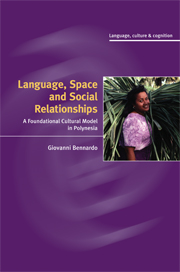Book contents
- Frontmatter
- Contents
- List of figures
- List of tables
- Preface
- Acknowledgments
- List of abbreviations
- 1 A foundational cultural model in Tongan language, culture, and social relationships
- 2 The Kingdom of Tonga: country, people, and language
- Part I Space in Tongan language, culture, and cognition
- 3 Space in Tongan language
- 4 Space in Tongan cognition
- 5 Tongan culture and space
- Part II Radiality
- Part III Radiality in social relationships
- References
- Author Index
- Subject Index
3 - Space in Tongan language
from Part I - Space in Tongan language, culture, and cognition
Published online by Cambridge University Press: 19 August 2009
- Frontmatter
- Contents
- List of figures
- List of tables
- Preface
- Acknowledgments
- List of abbreviations
- 1 A foundational cultural model in Tongan language, culture, and social relationships
- 2 The Kingdom of Tonga: country, people, and language
- Part I Space in Tongan language, culture, and cognition
- 3 Space in Tongan language
- 4 Space in Tongan cognition
- 5 Tongan culture and space
- Part II Radiality
- Part III Radiality in social relationships
- References
- Author Index
- Subject Index
Summary
Language for space in Tonga
In the village of Houma, on the island of Vava'u in the northern part of the Kingdom of Tonga, Polynesia, it is Sunday. The morning sun is beaming on the corrugated iron of the small local Wesleyan church. Most of the village people are congregated within the freshly repainted walls of the church. The singing of the hymns seems to linger within the building, but it is easily pouring out of it through the numerous glass doors always left open for air circulation. The modulated sound slowly fills the air and seems to push away the last swirls of smoke left behind by the many fires being used for the underground ovens where the food for the large Sunday meals is almost finished cooking.
A few youngsters hang around outside the building, occasionally peeking in. Some of them hold babies or younger siblings in their arms; one is trying to calm down a crying baby possibly awoken by a high-pitched note. Suddenly one of them points towards the back of the church and starts laughing; others join in immediately. Sunia's horse has gotten free from the tree where it had been loosely tied up, and is taking a trot.
Information
- Type
- Chapter
- Information
- Language, Space, and Social RelationshipsA Foundational Cultural Model in Polynesia, pp. 41 - 87Publisher: Cambridge University PressPrint publication year: 2009
